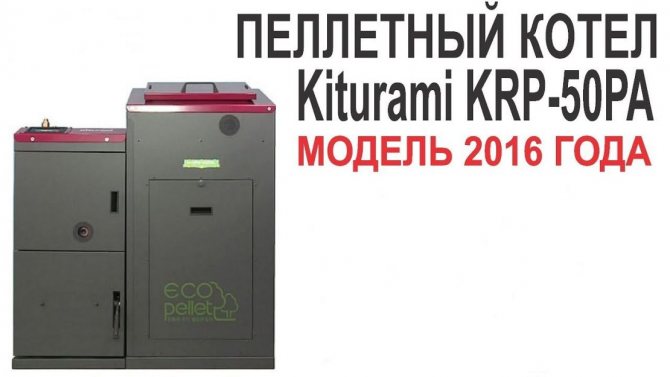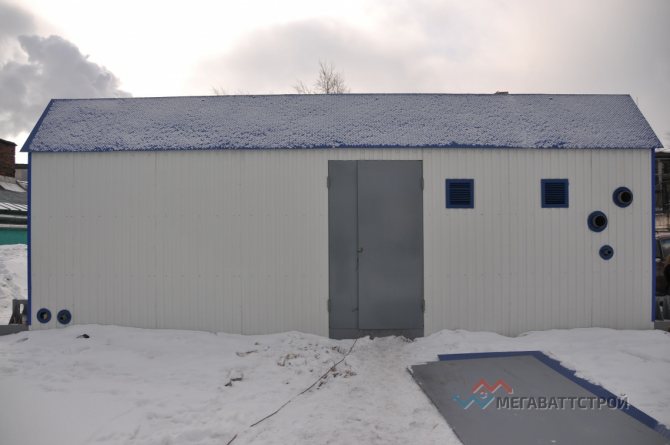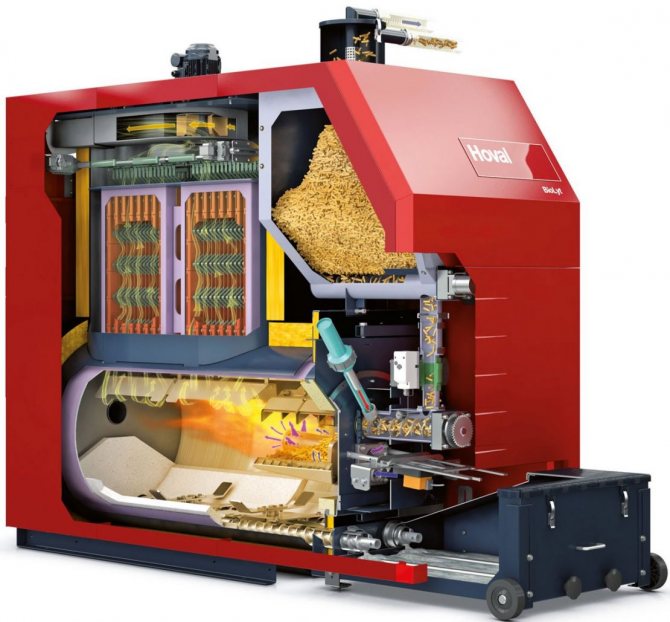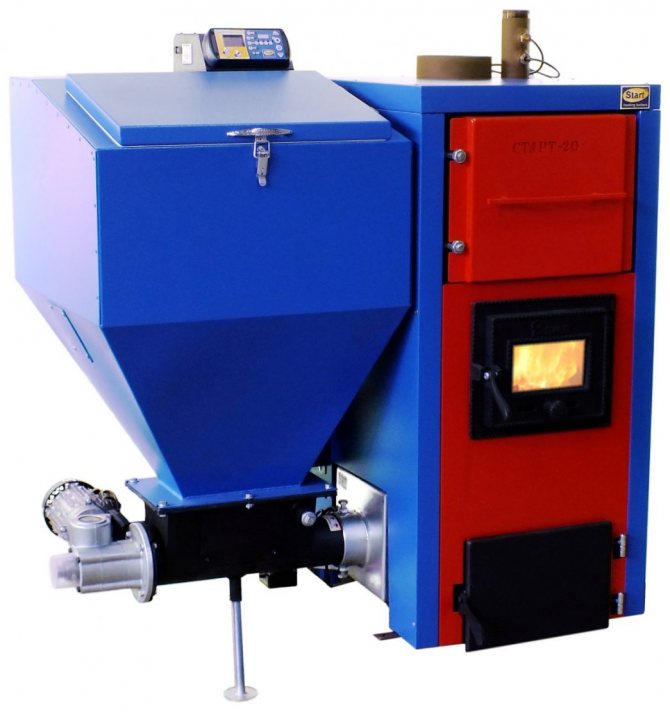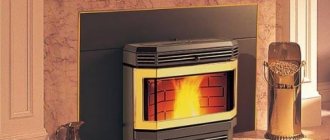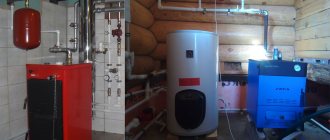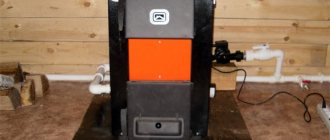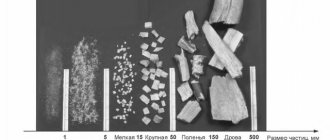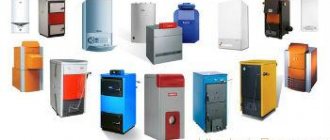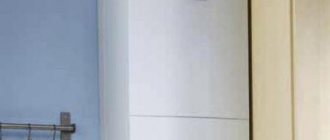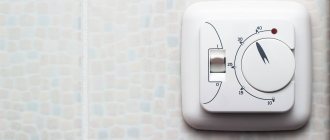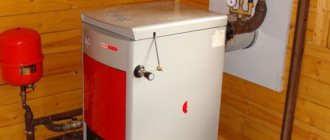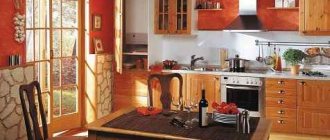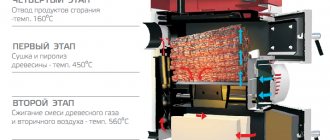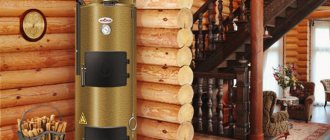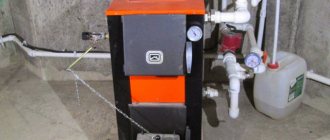Types of pressed fuel briquettes
Heating units operating on pressed briquettes are easy to maintain and do not need equipment for storing fuel and its automatic supply. Briquettes can be used to replace other types of solid fuel without upgrading the boiler.
The use of briquettes obtained by the pressing method as fuel greatly simplifies the supply of fuel to the furnace, there is no dirt and dust, and too frequent removal of slag is not required.
The main types of such fuel:
- Wood fuel briquettes are obtained by pressing the crushed dry wood waste: chips, bark, sawdust. They have a cylindrical or rectangular shape, weight - 0.5-2.0 kg. Recently, a new technology for the production of this pressed fuel makes it possible to obtain short cylinders - washers that can be loaded into the boiler automatically.
- The raw material for the manufacture of coal briquettes is small coal, which is not suitable for combustion in the furnace due to the fact that it spills out through the grate. To obtain durable products in the form of a cube or cylinder, resin, protein, molasses, soda and other binding components are added to the coal fines.
- Fuel briquettes can be pressed from crop waste: flax, rape and grain straw, sunflower seed husks, chopped corn stalks.
Among solid fuel heating units that use, among other types of fuel, pressed briquettes, Dacon units are very popular with consumers.
Storage rules for briquettes for boilers
In order for the briquettes for the boiler to retain their useful qualities as long as possible, you should adhere to some rules:
- Protect from water. Direct contact with moisture is dangerous for granules, which swell and lose their quality.
- Provide dust cover. Aggressive environment has a negative effect on small-fraction briquettes. From dust and wind, they can reduce the heat capacity.
- To prevent condensation from forming, a ventilation system is needed.
- Cover the fuel with foil during the off-season. This will protect against condensation during temperature changes.
Advice! In frosty, snowless weather, briquettes are conveniently stored outside. You just need to cover from the snow, protect from the wind. If the granules are frozen, they should not be thawed, but immediately thrown into the firebox. If the fuel gets wet, it must be dried as soon as possible.
How much does peat weigh?
As mentioned above, peat of different maturity levels has a different degree of water saturation, and, accordingly, a different volumetric weight. This can also apply to the product being sold. The table shows the average theoretical data on the weight of peat depending on the moisture level.
Specific gravity and density of peat in 1m3. Volumetric weight of peat in the table
| Name | The physical state | Density (g / cm3) | Specific gravity (kg / m3) | Bulk (bulk) weight (t / m3) |
| Wet peat | (water-saturated substance) | 1–1,2 | 1000–1200 | 1–1,2 |
| Peat dry | solid | 0,2–0,4 | 200–400 | 0,2–0,4 |
| Moist peat | solid | 0,6–0,8 | 600–800 | 0,6–0,8 |
The bulk weight of peat also depends on the degree of decomposition and belonging to the group, so at the same moisture content of up to 85%, high-moor peats are heavier than low-lying peats, but if the moisture content is more than 85%, the weight of low-lying peat will be higher.
How to properly heat the boiler with wood briquettes
The economic efficiency of wood briquettes is observed only if the boiler is properly loaded and fired. There are simple rules to help increase the operating time from one bookmark and the amount of accumulated heat in the heating system:
- Initially, a small amount of wood or sawdust is ignited.
- After burning out, briquettes are placed in the firebox.
- If it is necessary to quickly warm up the room, the pressed boards are laid so that there is a sufficient gap between them. The briquettes will burn out faster, but will give off more heat. For long-term burning, the plates are laid with a minimum gap between them. This arrangement is one of the features of burning wood briquettes in pyrolysis boilers. To prevent the appearance of an open flame, it is required to lay the slabs with a minimum gap between them.
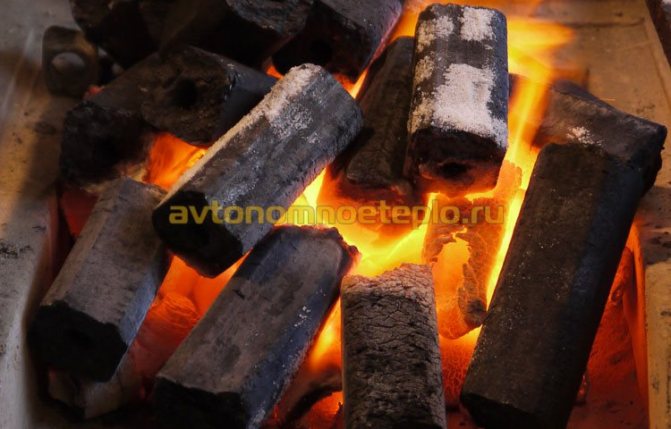
The pressed fuel contains a minimum amount of sulfur, a non-combustible residue, therefore, there is no negative impact on human health. If everything is done correctly, the bars burn with an even flame without sparks, crackling, etc.
Can briquettes be used for a wood-burning boiler
Fuel briquettes burn, emitting small amounts of sulfur and soot. Unlike firewood, the same temperature is maintained during the entire combustion period, which has a beneficial effect on the condition of the heat exchanger.
Briquettes are suitable for the following types of boilers:
- Classic units.
- Pyrolysis models.
- Boilers with automatic fuel supply, provided that a "washer" is used.
Almost all solid fuel equipment is capable of operating using wood briquettes. It is optimal to use those models, the technical documentation of which clearly indicates the possibility of using pressed fuel.
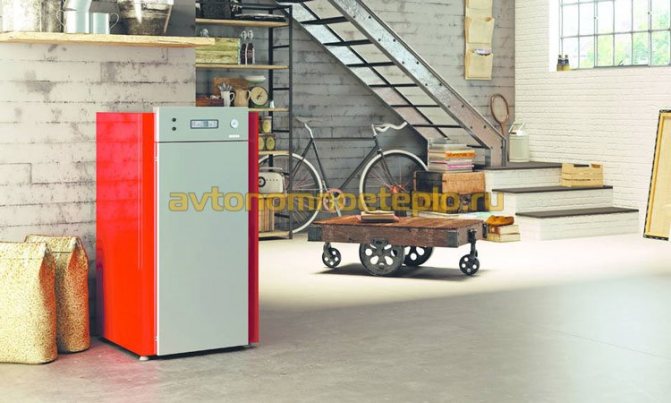

Features of the firewood stove
To provide high-quality heating, you need to know how to heat a solid fuel boiler with wood efficiently and economically. For kindling, chips are laid down, on top of which 3-5 firewood with a diameter of up to 15 cm should be placed. It is recommended to put crumpled paper between the chips so that the wood flares up faster.
After the first tab burns up, the firebox is filled with large firewood. To achieve the most complete and efficient burning of wood, you can put 1-2 large logs in the firebox with a frequency of 30-40 minutes. In addition, this method will help to reduce the consumption of firewood.
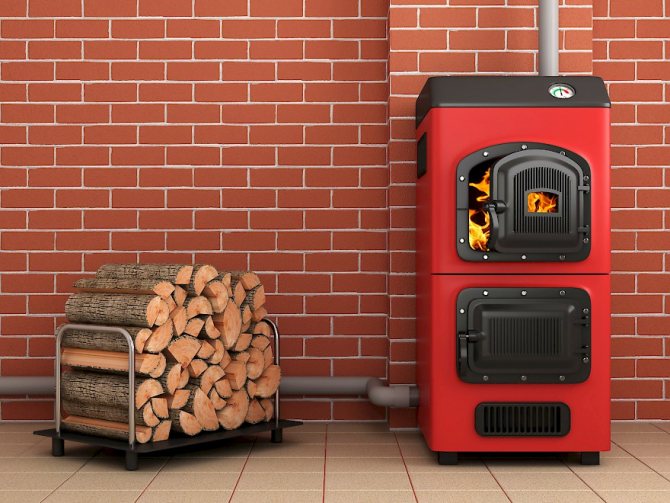

When the furnace is completely filled with large firewood, an ordinary modern solid fuel boiler is able to maintain a fairly intense combustion for 3-4 hours. Long-burning boilers work even longer on one tab. It is generally not recommended to heat such models with small firewood, which does not completely burn out in them due to increased gas emission. The optimal size of the logs is 15-30 cm in diameter.
If you figure out how to properly heat a TT boiler, then the choice of firewood is of great importance. The moisture content of the wood should not be higher than 20%, otherwise the efficiency of the equipment will be lost. In some cases, to increase the duration of burning, raw firewood is specially laid in the firebox, which takes longer to burn. However, it must be borne in mind that this leads to an increased release of tar, which settles on the walls of the furnace and on the chimney, and this causes a deterioration in draft. As a result, the boiler has to be cleaned more often. In order for the wood to have an optimal moisture level, it must be dried under a canopy for about 1.5-2 years before use.
If you want to increase the burning time of one bookmark, then you do not need to use raw wood, but set the correct position of the gate valve and thermostat. These provisions for each boiler TT model are determined empirically.
Peat briquettes are biofuel
Manufacturers of peat briquettes claim that this is a biologically safe fuel, and this is one of the main advantages for many buyers.
This statement is based on the fact that such products are produced on modern equipment, and for this, the latest technologies are used. The technological process itself consists in the fact that when the press is operating under high pressure, moisture is displaced from the workpieces. Moreover, peat is preliminarily dried.As a result, buyers are offered light bars that look like large dark tablets. Thus, the production does not use additional chemicals or any other substances that could spoil the peat and its natural environmentally friendly qualities.
Benefits of heating with peat briquettes
As buyers who have already used this fuel to heat their homes have noticed, with the correct air supply, such briquettes maintain heat for about ten hours. This is very convenient because at night there will be no need to throw in additional raw materials. It is estimated that one ton of peat briquettes gives off the same amount of heat as four cubic meters of good quality wood.
You can also emphasize a number of other advantages that show good performance, thereby giving this type of fuel to conquer new sales markets.
- Peat briquettes can be used to heat all types of oven equipment.
- After incineration, only one percent of the ash from the total mass of the raw material remains from the peat briquette.
- When heating, little soot and smoke are emitted, so the chimney is not susceptible to clogging.
- Heat transfer during heating comes out from 5500 to 5700 kcal / kg.
- Affordable price.
- This fuel is easy to transport.
- Peat blocks do not lose their combustible qualities for several years.
- Natural product with minimal impurities.
Gardeners and gardeners have found another use for the waste that remains after burning peat briquettes. It turned out that the ash left after the heating process is a good phosphorus and lime fertilizer.
Section of a modular solid fuel boiler room.
(click on the image to view)
Since all the equipment of the boiler room is placed in compact transportable rooms (modules or blocks), the main requirements for which, as a rule, are transportability and versatility, then the transport unit of the boiler room is a block (aka module).
In general, a modular solid fuel boiler house is usually transported using standard vehicles and does not require separate permits for transportation across the territory of the Russian Federation. Often, a block-modular solid fuel boiler house consists of a single block in which all the main and auxiliary equipment used is located. Such solutions are usually used for modular hot water boilers for pellets (wood pellets) and fine coal (which does not require additional processing) in the heat output range up to 300 kW. At the same time, a standard container (module) has dimensions of 2.4 m by 5.5 m and a height of 2.4 m. The dimensions are selected in such a way as to ensure ease of transportation of the entire module. This solution is suitable for hot-water modular solid-fuel boiler houses with a thermal power not exceeding 300 kW, with fuel that does not require special storage or processing conditions and the simplest one-stage chemical water treatment or without it, it is also possible to install equipment for chemical deaeration of make-up water of small capacity in the module. Modular solid fuel boilers are usually transported ready for use. When buying a modular boiler room, it will be delivered to you 90% ready for commissioning, with the exception of the chimney, which is not connected to the modular building, since, as a rule, it has a height of at least 6 m. The chimney is transported in the same car as the main module and is connected to the boiler room during its installation at the customer's facility.
Classification
Peats are classified in relation to the composition of phytomass (trees, grasses, mosses), trophicity (the amount of nutrients contained in plants) into three categories:
- Top (or high) peat. Has high acidity and low degree of decomposition. Differs in moisture capacity up to 1200%, is characterized by high ash content and calorific value.
- Horse light (or transitional) peat.Refers to the upper layer of the deposit, the degree of decomposition of plant residues is about 15%. The weight of peat 1 m3 in such a layer is quite small, and amounts to 150 - 250 kg. In its natural state, it has a large gas and water absorption capacity (1 kg of such peat can absorb up to 10 liters of water).
- Low-lying peat (or bottom). This type includes ancient deposits up to 30 thousand years old. Substance with a fine, light and moist structure. The degree of decomposition of plant residues is more than 15%, it has a high humus content, this is "mature" peat. The weight of a cubic meter is 350 kg / m3. The medium is slightly acidic, with a high content of nitrogen, phosphorus, potassium and other organic substances useful for garden plants.
- Fibrous peat is a special type of peat containing plants with a pronounced fibrous structure. Such peat is not sifted and molded like other types for further use, but only crushed into small lumps.
Birch fuel briquettes type "RUF"
No bark or other additives. 100% environmentally friendly wood (fine birch dust + plywood production waste).
Depending on the delivery batch, there may be no RUF inscription on the briquettes.
| Parameters: | |
| Briquette size (WxDxH), mm: | 150x100x60 (brick-shaped) |
| Pallet size (WxDxH), mm: | 800x1200x1360 (96 packs) |
| Structure: | birch dust + veneer |
| Color: | white |
| Calorific value: | n / a |
| Humidity: | up to 8-10% |
| Density: | 830 kg / m3 |
| Ash content: | up to 0.7% |
| Packaging: | polyethylene |
| Weight of 1 package: | 10 kg (+/- 5%). in 1 ton - 100 packages |
| Packaged: | 12 briquettes |
Suitable for all types of stoves, ideal for solid fuel boilers, for home heating, for baths and saunas.
PRICES INFORMATION
Choosing a wood briquette boiler
The choice of a long-burning boiler on pressed wood briquettes can be difficult due to the large range of products offered. The domestic market offers models made in Russia, European countries and neighboring countries.
To facilitate the selection of equipment, all proposed boilers for burning briquettes can be divided among themselves into several categories, according to the territorial principle - the country of manufacture:
- Germany - Bosch Solid.
- Czech Republic - ATMOS, Dakon (owned by Bosch), Wattek.
- Russia - Nibe Viking, Zharstal Dobrynya, Dragon.
- Turkey - Radijator.
- Poland - Heiztechnik.
- Italy - Ferroli.
The proposed list contains boilers for burning briquettes using the principle of pyrolysis combustion. All models enjoy constant popularity, which is clearly shown by the sales statistics.
Solid fuel boiler long burning with a water circuit: advice to owners
In order for the equipment to serve for a long time and with maximum efficiency, it must be chosen correctly. The recommendations below are for those who are just about to buy a system.
- l with two circuits in terms of power is ¼ superior to a single-circuit analogue. Therefore, the power of the first must be at least 15 kW, while for the second 12 kW is enough. The larger the heated area, the more powerful the equipment must be.
- For a good supply of hot water, the second chamber and the heat exchanger of the boiler must be made of steel or copper. The cast iron firebox has a long service life.
- capable of delivering about 8 liters of water per minute. If this amount is not enough for domestic needs, it is recommended to purchase a boiler with a boiler.
- Maintenance of the unit is quite simple - you only need to clean the ash pan and load fuel from time to time. Long-burning boilers can last 5-7 days on one tab.
Before the first start-up, the owner must carefully inspect the pipes for leaks and the boiler itself - it must not let smoke into the room. The same goes for the chimney system. The chimney, piping and radiators need to be cleaned once a year.
For preventive maintenance, drain the water from the system. To do this, an additional pipe is attached in the return circuit by means of a tee, at the end of which a plug is installed.
Solid fuel heating boiler
Blue fuel is not yet available to everyone. It often happens that there is no gas pipeline outside the city, so the question arises of finding alternative sources of heating. Electricity is an expensive fuel. The most accessible and in demand are ordinary wooden logs, so heating equipment designed for this type of fuel is still relevant today. To heat a country house, the easiest way is to use wood-burning boilers with long burning.
When choosing one or another ready-made model, it is important to take into account several serious points:
- First, you need to pay attention to the principle of operation of wood-burning stoves with a water circuit.
- Secondly, it is worth taking into account the availability of additional equipment that can be used to increase the productivity of the installation.
- Thirdly, it will be useful to take into account what positive and negative characteristics long-burning boilers equipped with a water circuit have.
Having answered all three questions, you can decide whether to choose such an option, whether it will be reliable in the conditions of harsh winters, or still give preference to equipment that runs on electricity or coal.
Features of briquette boilers
The briquettes are loaded into a hopper, from where they are gradually directed by a screw in a special burner. During the operation of the device, air is blown onto the burner, which contributes to the maximum complete transfer of heat. Depending on the type of burner, a flare or volumetric boiler on fuel briquettes is emitted.
Sources of
- https://kotel-otoplenija.ru/tverdotoplivnyj-kotel-na-pressovannyh-toplivnyh-briketah
- https://naruservice.com/articles/udelnyj-ves-torfa
- https://avtonomnoeteplo.ru/otopitelnye_kotly/227-otopitelnye-kotly-dlya-doma-na-tverdom-toplive.html
- https://kotel.guru/kotly/tverdotoplivnye/torfyanye-brikety-dlya-otopleniya-i-cena-na-etot-produkt.html
- https://lentoplivo.ru/brikety
- https://tt-kotly.ru/na-briketah/
[collapse]
Solid fuel boilers "Teplodar"
We bring to your attention the models of heating boilers most popular among consumers:
- Boiler "Comfort". Refers to affordable, budget options. It is used for small premises (up to 100 m2). It has an elongated body shape, which makes it possible to lay firewood, the length of which reaches half a meter. There is a large ash pan at the bottom of the building, since a lot of waste is generated during the combustion of fuel. A water circuit is installed on the heat-removing surface, which is characterized by efficiency and uninterrupted operation. This compact boiler is quite efficient: its efficiency is 72%.
- Copper "Kupper". It is a versatile modification that combines compact dimensions and good power. It copes with heating large rooms with an area of 50-300 m2. Power indicators are regulated in the range of 30-100%. The design features of the "Kupper" boiler make it possible to lay various types of fuel, for which you will additionally need the installation of special burners.

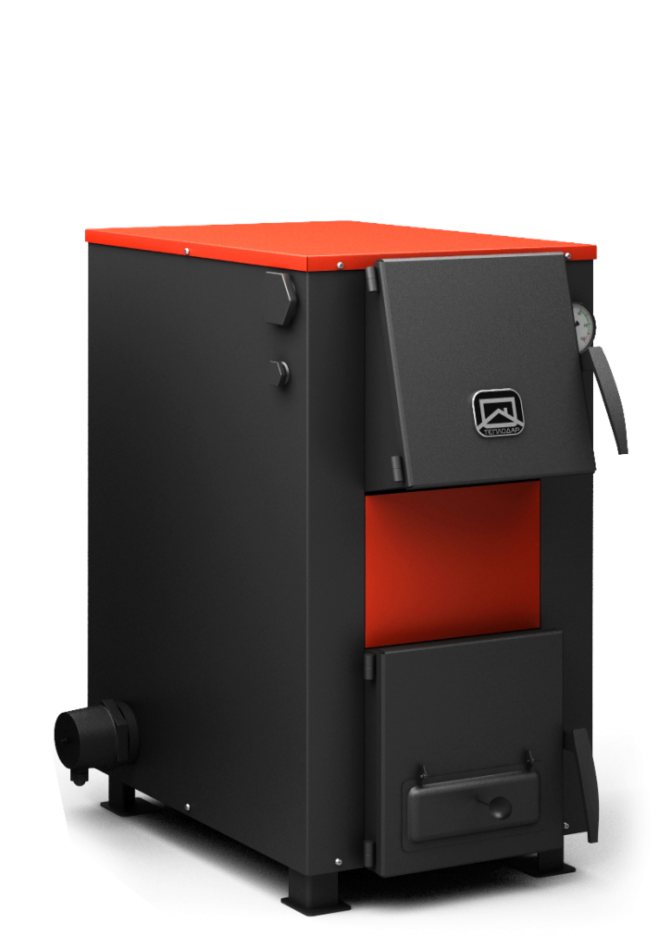
- Copper "Kupper PRO". It represents a number of long-burning units: uninterrupted operation of the equipment for 8 hours is ensured by only one solid fuel load. This duration is possible due to the combustion of secondary air in a separate chamber, as well as thanks to the grate that collects heat. "Kupper PRO" is installed in rooms with an area exceeding 200 m2. It is possible to equip the boiler with gas and pellet burners.

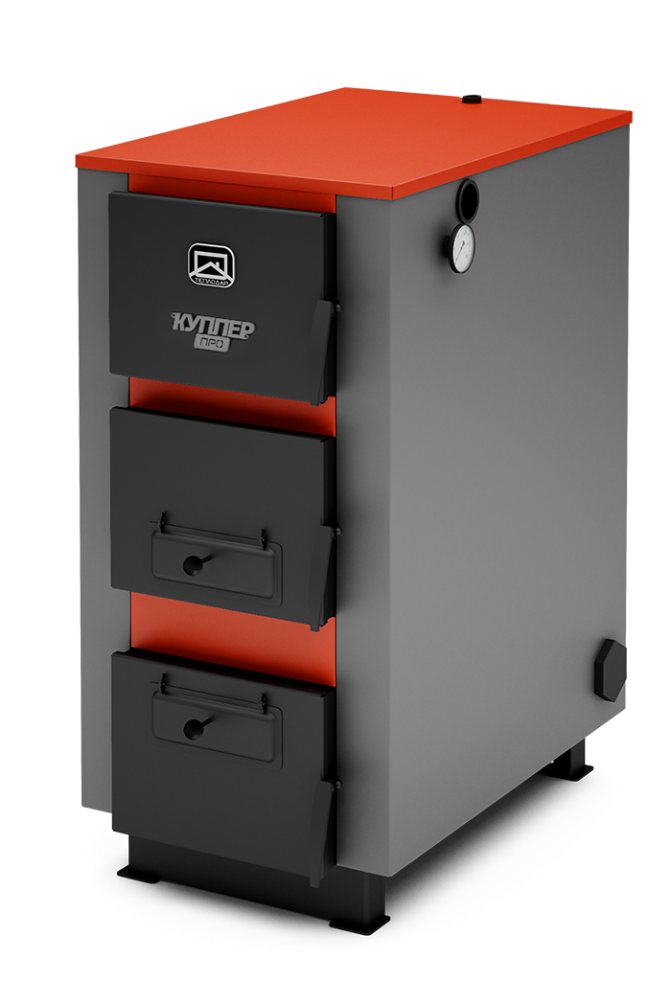
The choice of a solid fuel boiler should be approached responsibly, since it is necessary to take into account many parameters on which the efficiency of the equipment will depend. If it doesn't work out on your own, we recommend getting a specialist consultation. To ensure the long-term operation of heating equipment, it is important to follow the rules of use, regularly clean it and periodically carry out a technical inspection.

